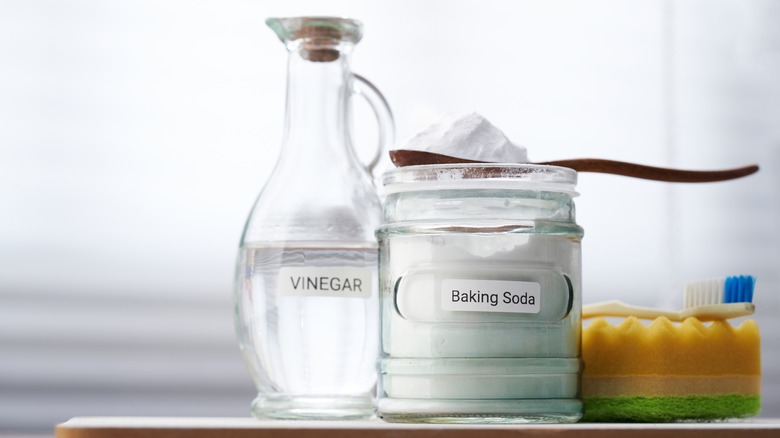How To Get Black Mold Off Of Your Shower Mats
You've installed your new handy, dandy suction cup non-slip mat in your tub or shower to help prevent falls. You're loving it until you notice icky black stuff growing beneath it. If the mat's clear, you might actually even see the inky gunk lurking under foot. Yes, where there's moisture and humidity, mold usually follows given enough time. It not only looks bad but can be a health menace as well. What comes next is a good news, bad news situation.
The bad news is that you're going to have to clean this type of plastic or rubber mat regularly to keep it acceptably hygienic and looking nice. The good news is that you have options for keeping your useful mat spic and span including tried and true bleach. If avoiding the use of chemicals in your home is a priority, not to worry. Baking soda, vinegar, and hydrogen peroxide can also help with this cleaning task.
Using non-toxic solutions for cleaning bath and shower mats
Baking soda and vinegar are both good products for killing mold. In fact, each of these kitchen staples has properties for killing different types of mold so they're often used together, according to Maid Brigade. Hydrogen peroxide can be substituted if you don't have vinegar on hand.
If you're cleaning a mat in a bathtub, you can simply peel it off the surface and lay it upside down so that the suction cups, if applicable, are facing you. Plug the drain and run enough warm-to-hot water so that the mat is submerged. Sprinkle about 1 cup of baking soda over the mat, then add either 1 cup of vinegar or 1 cup of hydrogen peroxide to the water. Let the mat soak in the solution. For really dirty mats, you might need to soak them for up to two hours. Mildly dirty mats may need as little as 30 minutes to get the job done. Before rinsing, scrub any areas that need more attention with a stiff brush. No tub in your bathroom? You can still soak a mat by using a stopper that lays over the shower drain. If that's not an option, try soaking the mat in a bucket with the same solution.
Using bleach to clean bath and shower mats
It's easy to understand why bleach is not everyone's first choice as a cleaning solution. It contains harsh chemicals that can be an irritant to both eyes and skin, and breathing it over a long period poses other serious health risks. It's best to wear rubber gloves if you're getting it on your hands, so in this cleaning scenario you'll need them. Make sure you turn on the bathroom vent or, better yet, open a window before you begin when using bleach as a cleaner.
Even with the drawbacks and required precautions, when it comes to ridding shower mats of mold and mildew, bleach works quite well while killing many types of bacteria, fungi, and viruses that can also lurk in dank bathrooms. You basically follow the same instructions as using non-toxic products when it comes to removing the mat, turning it over, and covering it with hot water. But instead of baking soda and vinegar or peroxide, you just add 1 teaspoon to 1 tablespoon of bleach for each gallon of water in the tub or shower stall. Soak the mat until it's clean, and then rinse thoroughly.
You'll likely find that cleaning your non-slip mat regularly when you tidy up the bathtub or shower floor will keep it looking good longer without the need for excessive scrubbing. Also, always be sure to place your thoroughly air-dried mat into a clean tub or shower to thwart future mold growth.


